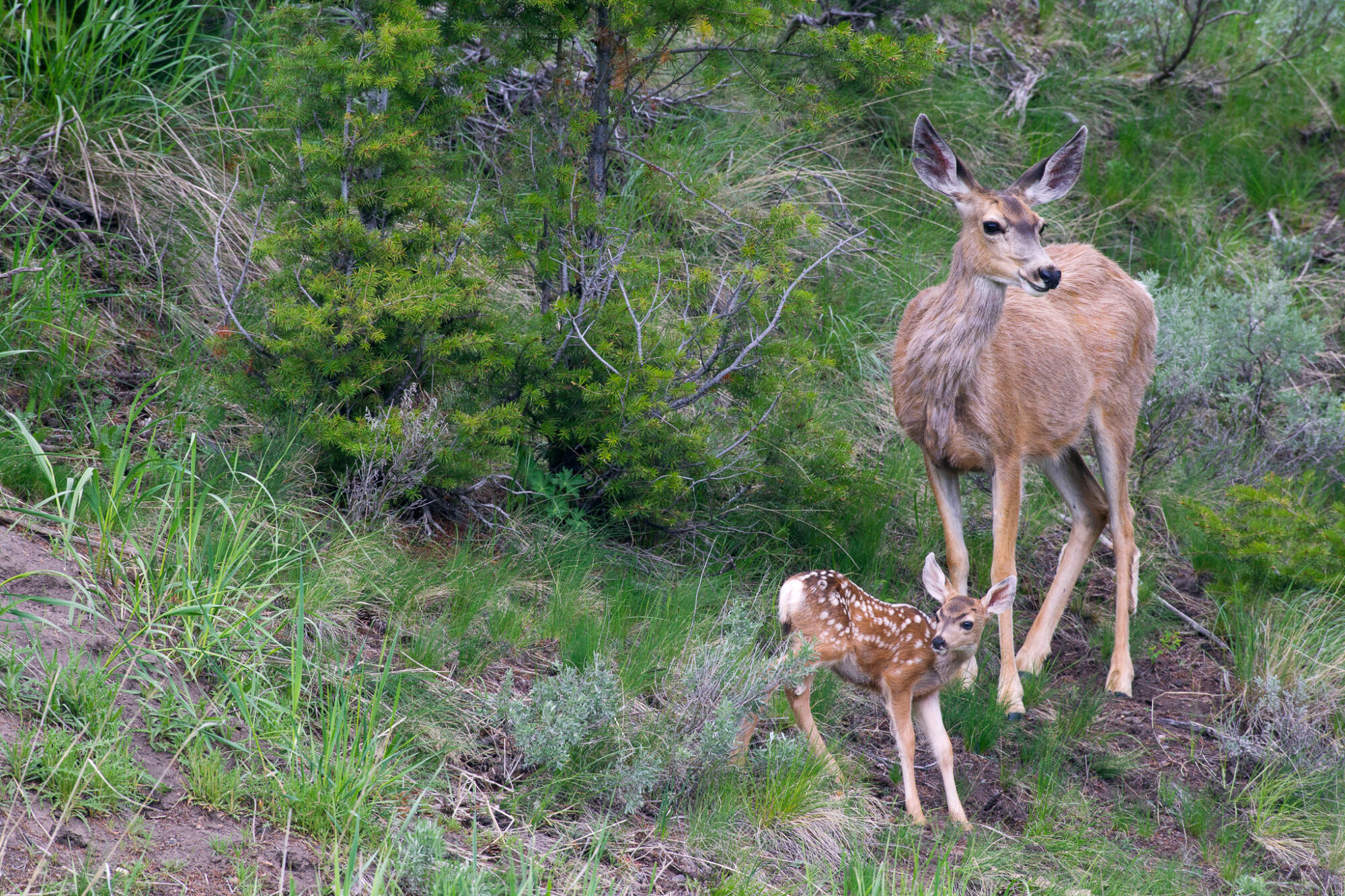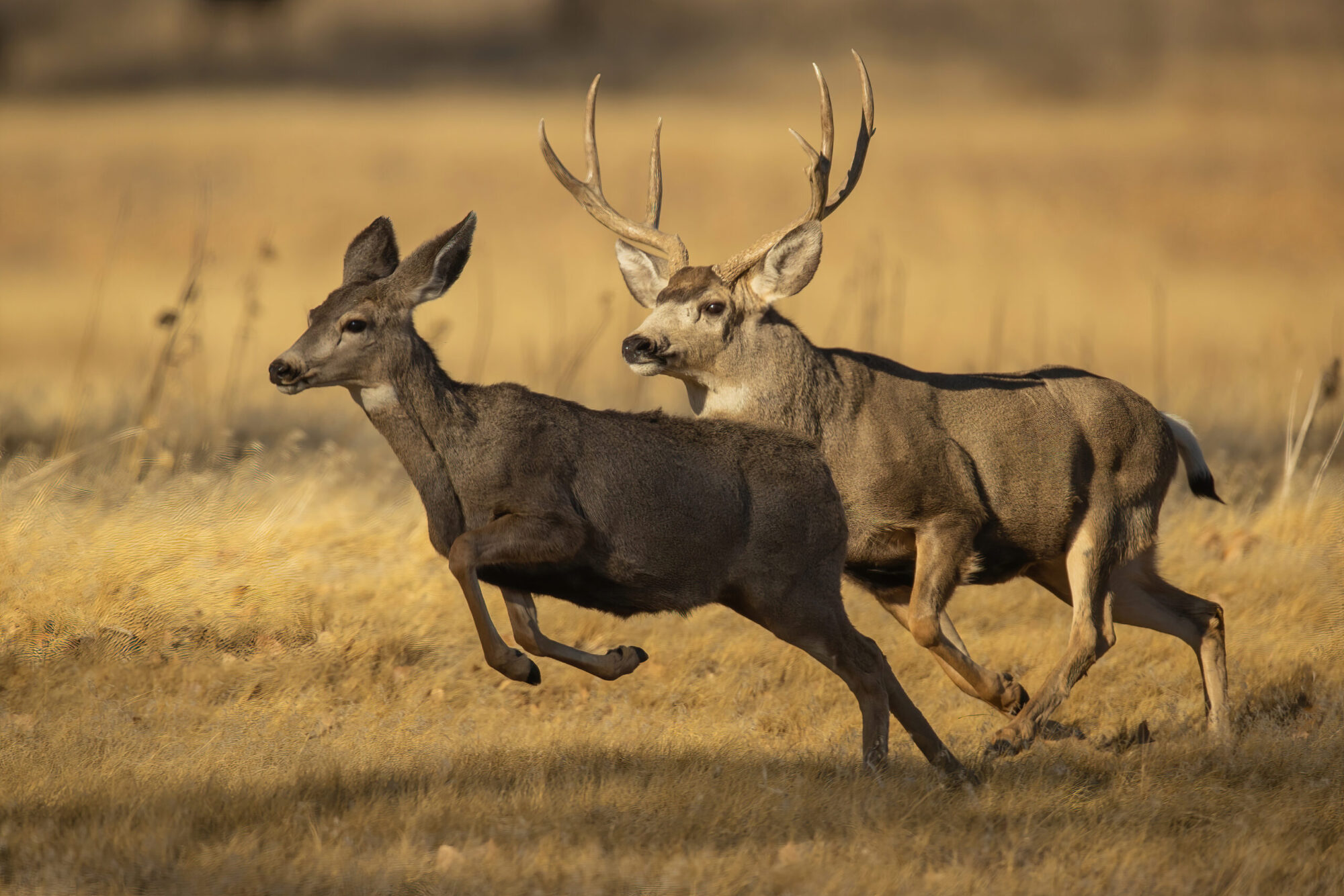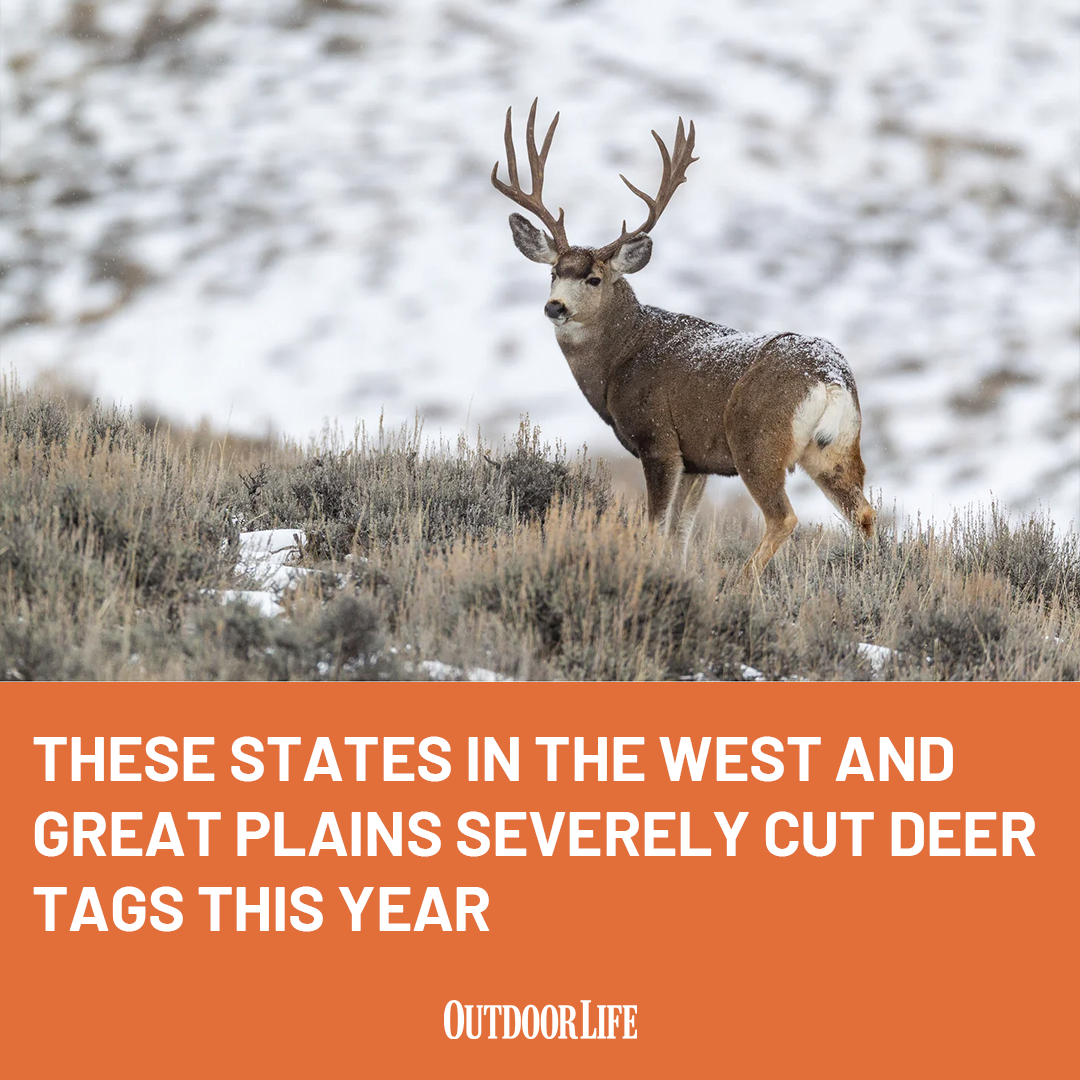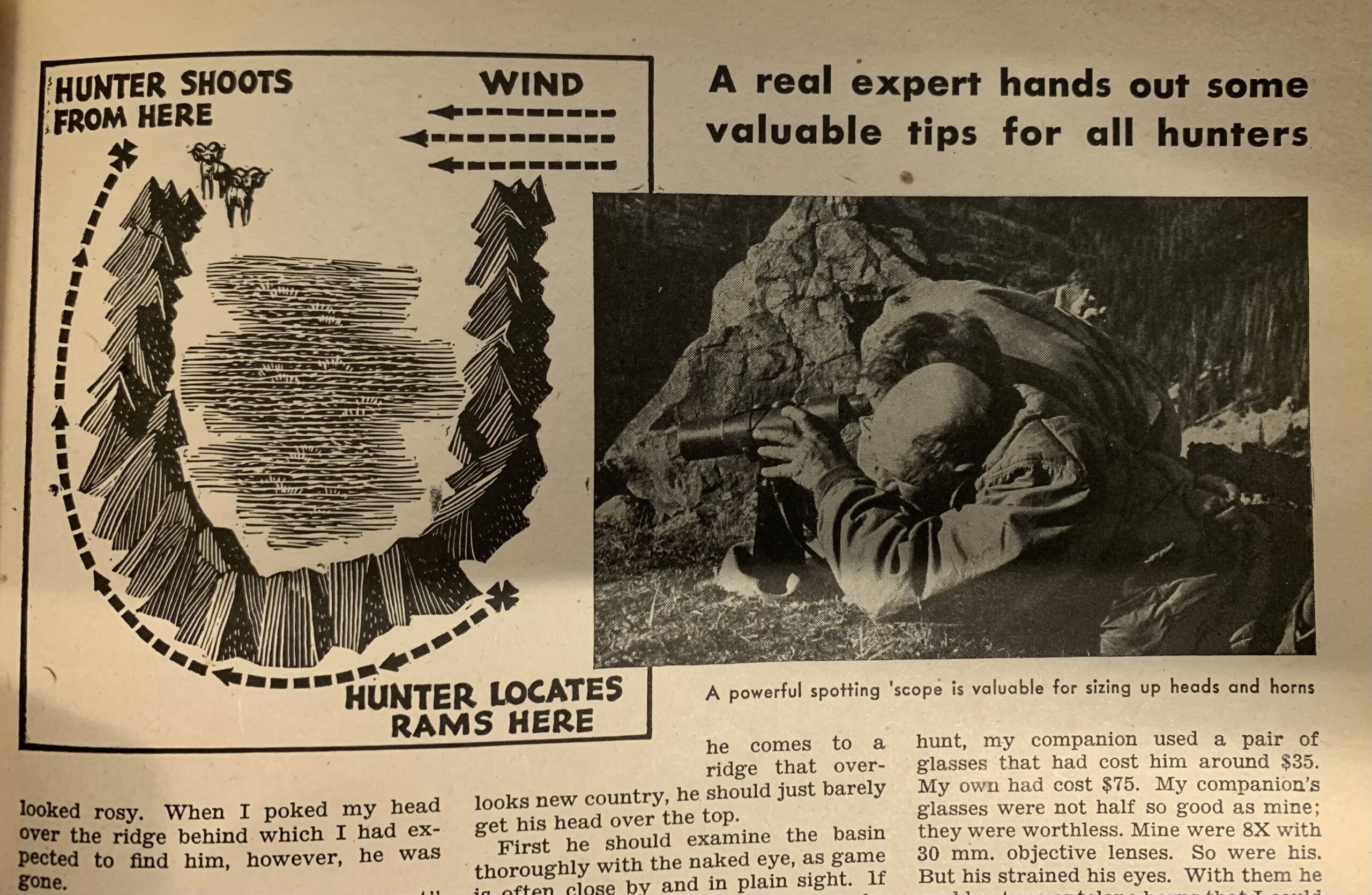That’s why many states in the Mountain West and Great Plains states approved deer tag reductions for the 2023 to 2024 deer season. (California and South Dakota have not returned requests for comment.) Here’s a guide to all the states that have announced reductions to their available deer tags so far.
Colorado
Number of Deer Tags Cut: 7,900

That’s why CPW enacted major mule deer tag reductions on May 10. Most of the reductions take place in the so-called “Severe Winter Zone,” according to the 2023 Colorado Big Game brochure. The area from the northwestern town of Rangely to central Steamboat Springs and north to the Wyoming border saw the worst winter in 70 years. As a result, 5,000 male and either-sex mule deer tags across 17 game management units were eliminated. Additionally, 2,900 doe tags in 16 of those 17 GMUs were also eliminated. This makes for a total of 7,900 fewer deer tags.
“This winter has been historic in many ways,” CPW biologist Darby Finley said in a press release about the reductions. “These recommendations were not easy to make, and we know they will impact more than just CPW. However, we believe these substantial reductions in licenses will allow herds to recover as quickly as possible.”
Idaho
Number of Deer Tags Cut: 200+
While the Idaho Department of Fish and Game didn’t technically cut any deer tags while establishing their 2023 quota, they did make other decisions that would help offset the immense winter loss they faced in the southeastern part of the state. Both doe and fawn survival rates in the Southeastern region were low—47 percent and 8 percent, respectively. Just two of 30 collared deer in that region made it through the winter, deer and elk coordinator Toby Boudreau tells Outdoor Life.
IDFG cut antlerless opportunities following a harsh 2016 to 2017 winter, and had considered reinstating those tags for this upcoming season.
“Populations had rebounded to a point where we were going to start offering some of that either-sex and antlerless opportunity in the Southeast and Upper Snake regions again,” Boudreau says, noting that 460 antlerless tags were on the table in earlier season-setting discussions. But come January 2023, wildlife managers revisited that decision and decided to pull back the proposed hunts.
“We were just recovering from the previous winter when the next winter hit us in the back of the head.”

Additionally, nonresident hunters have returned 213 deer tags so far this year. Normally, those returned tags go on sale for nonresidents to purchase. But that won’t happen this year, Boudreau explains. Whitetail hunters, on the other hand, will get longer seasons in three units and Unit 14 will see expanded hunter opportunities to help offset chronic wasting disease.
Kansas
Number of Deer Tags Cut: 253
The Kansas Department of Wildlife and Parks cut a comparatively meager number of deer tags for the 2023 season. Drought and habitat loss continue to stress deer populations in parts of the Sunflower State, big game program coordinator Levi Jaster explained during a KDWP Commission meeting on April 27. The 253 tags include 13 mule deer tags, 95 resident mule deer permits, and a net loss of 145 nonresident whitetail tags. (A total of 374 nonresident whitetail deer permits were cut across 10 of the 18 deer management units, but KDWP also added 229 across six more deer management units. Deer tags in the remaining two units were unchanged.) All archery tags statewide remain untouched.
KDWP also added 229 nonresident whitetail deer permits across six deer management units, bringing the net loss of nonresident opportunity to 145 tags. Deer tags in the remaining two units were unchanged. All archery tags statewide are also the same, as noted in minutes from the Commission meeting.

For perspective how small those whitetail deer tag cuts really are for Kansas, consider that hunters harvested more than 81,000 whitetails during the 2020 to 2021 season, according to KDWP’s latest available data. The 95 resident mule deer tags that were cut will have a bigger impact on resident mule deer hunters, who harvested 1,747 deer that same season.
Montana
Number of Deer Tags Cut: TBD
While most states established tag quotas in late April or early May, Montana hunters won’t have hard answers about tag reductions until June 8 when the Fish and Wildlife Commission votes on recommendations that aren’t publicly available yet. But those recommendations will likely include turning a handful of either-sex mule deer tags in regions 4, 6, and 7 to antlered-only tags, Montana Fish, Wildlife, and Parks communications and education administrator Greg Lemon tells Outdoor Life. This change would keep more does on the landscape to help populations rebound after bad winter weather in eastern Montana caused some winter mortality.
North Dakota
Number of Deer Tags Cut: 10,800
Like much of the Midwest, deer in North Dakota rely on private land habitat to survive. Since 93 percent of North Dakota is privately owned, agricultural lands sustain the ample whitetails and shrinking mule deer North Dakotans love to hunt. But after harsh winter conditions hammered the whole state, a substantial 10,800 fewer deer tags are available to hunters for the 2023 season.

“The severity of winter conditions this year was record setting, particularly in the eastern half of the state,” North Dakota Game and Fish Department wildlife division chief Casey Anderson said in a press release, pointing out that the state’s 53,400 remaining deer tags make for the lowest quota in seven years. “Conservative license allocations are intended to maintain hunting opportunities while continuing to encourage population growth.”
Of particular concern is how quickly North Dakota’s CRP is shriveling. Due to expiring CRP contracts and limited re-enrollment of expired lands, 85 percent of the 3.4 million acres of quality habitat that were present in 2007 will be gone by 2026. And while correlation doesn’t always equate to causation, quality habitat is necessary for deer populations to rebound from detrimental winters; without it, recovery is difficult. This delicate relationship shows in North Dakota: mule deer numbers in the western part of the state dove 29 percent from last year.
While land doesn’t have to be enrolled in CRP to help mule deer, Anderson says, it must fulfill essential winter and fawning habitat needs “for numbers to bounce back effectively.”
Nebraska
Number of Deer Tags Cut: 8,350
During the fall 2022 season, Nebraskans saw the lowest mule deer buck harvest since 1981 and the lowest whitetail buck harvest since 1994. As a result, the Nebraska Game and Parks Commission approved a significant cut to tags for both species for the 2023 season.

Of the 8,350 total permits cut, 3,700 are nonresident either-sex or buck-only. (Statewide archery and muzzleloader tag cuts are included in that total.) An additional 2,325 “November firearm” permits and 2,325 antlerless permits were also eliminated. These figures include a mix of mule deer and whitetail deer tags, and antlerless mule deer harvest on public land (with some exceptions) was also prohibited. There are multiple reasons for these changes, what Nebraska Game and Parks Department big game program coordinator Luke Meduna calls the “three smoking guns.”
“About five years ago, our landowners asked us to reduce our deer numbers,” Meduna says, referring to complaints about high deer densities that destroyed crops. “We’ve also had a significant drought the last couple of years [that’s] reduced mule deer fawn production, so the harvest that our herds could sustain five years ago is pretty detrimental to them now. We also have some disease issues.”
Meduna explained how meningeal brainworms, CWD, and two consecutive EHD outbreaks have curtailed deer populations and forced some of the tag cuts.
“The role that CWD is playing in this all is somewhat unknown. That’s just one of those holes in the bucket that’s hard to quantify,” he says. “But by all accounts, this last year was a generationally bad harvest year for deer.”
Utah
Number of Deer Tags Cut: 8,421
When it comes to the record-breaking 2022 to 2023 winter, Utah was the epicenter of the damage. Ski resorts recorded 800-plus cumulative inches of snowfall. The Utah Department of Wildlife Resources put out ton after ton of supplemental feed for wildlife that relied on it as their sole food source. Officials postponed shed hunting statewide, sparking an outcry among resident and non-resident shed hunters. One hunt unit in Utah’s northeastern region saw 70 percent adult mule deer mortality and more than 90 percent fawn mortality.

All this loss culminated in major tag decreases. Overall, DWR cut 8,950 general-season buck permits. Of those, 7,500 were in the Northern Region, which accounted for a 31 percent decrease in the area. The Northeastern, Central, and Southeastern regions also saw decreases, but only by a few hundred tags each. An additional 105 doe permits were also axed. DWR added 600 general-season deer permits for the Southern Region and 34 limited-entry deer tags were also tacked on statewide. This puts the net loss at 8,421 tags.
DWR big game coordinator Dax Mangus explained how factors like poor and limited habitat, predation, and extreme weather negatively impact deer populations, especially the crucial fawn survival rate. These fluctuations set the stage for tag numbers every year, and were felt especially hard this year.
“The way we hunt [bucks] in Utah doesn’t drive deer populations,” Mangus said. “But what happens with deer populations drives how we hunt buck deer.”
Wyoming
Number of Deer Tags Cut: 4,410
Wyoming rounds out the list with a hefty mule deer tag reduction following the same bad winter that plagued Colorado, southern Idaho, and northern Utah. While pronghorn hunters saw the worst of the cuts with 10,290 tags lost, the Wyoming Game and Fish Commission also eliminated 4,410 mule deer tags across seven management regions after approving wildlife manager recommendations at an April 18 meeting. These cuts include both antlered deer and doe/fawn tags, and impact both resident and non-resident opportunities.

With the loss of those mule deer licenses comes an increase in whitetail deer opportunities. While 1,475 new whitetail tags for this season don’t offset the reduction, they do add more chances to put meat in the freezer than were available for whitetail hunters last year.
“We’re trying to keep a little bit of an edge for mule deer to do better than whitetail [deer],” Wyoming Game and Fish Department wildlife division deputy chief Doug Brimeyer told the Commission during the meeting.
Wyoming’s mule deer populations dropped by 31 percent from 1991 to 2016. Mule deer harvest has decreased from a 13-year high of more than 30,000 deer in 2016 to just 17,785 in 2022.
Read Next: This Wyoming Hunter Wants You to Buy a Deer Tag, But Not Use It
Final Thoughts on Deer Tag Cuts
Every year, state agencies must grapple with many factors when setting tag numbers. Extreme winter, drought, disease, and habitat issues are just a few variables that impact the future of deer populations—and the future of American deer hunting opportunities, as well. As long as hunter harvest remains a management tool in the wildlife conservation toolbox, tag cuts will be part of the status quo.




























